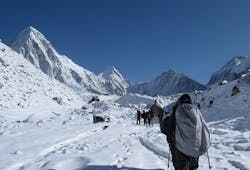Conquering Everest’s water contamination problem
A Ball State University team from Indiana is working to bring clean drinking water to a small, isolated community in mountainous Nepal that lies in the middle of the heavily congested pathway to Mount Everest.
Led by Kirsten Nicholson, a Ball State geological sciences professor - teams of faculty, students and alumni have started the Himalayan Sustainability Initiative. They have spent the last several years studying how contaminated the groundwater is that serves the 900-person community of Khumjung at nearly 17,000 feet.
“There is no modern sanitation or water lines in that part of Nepal,” Nicholson said. “Right now, people are just running hoses up higher, collecting water melting into streams and pools where people don’t visit.
“It’s a terribly impoverished area with a population of caring, giving people. It’s our goal that over the next few years, we can determine how polluted the water is and to find and drill wells to bring uncontaminated water to local residents.”
The small community, which lies near the base camp for trips up the world’s tallest mountain (the summit is 29,000 feet), sees about 20,000 visitors traipse through the area every year. And the numbers keep increasing.
“The way to the top of Everest has been a dumping ground since the 1950s,” Nicholson said. “The way to Everest has probably the most stunning views in the world, but there are tons of human waste that sits in mounds — hidden from human eyes — along with tons of discarded equipment and trash.
“When we looked at the problems, we thought that someone should help these people. And someone said, ‘Hey, we are Ball State geologists — that is what we do.’”
Nicholson and Klaus Neumann and Carolyn Dowling, fellow geological science professors, trekked with immersive learning classes in 2013 and 2014 to the area, battling harsh weather in addition to bouts of sickness.
“We were dropping like flies, with one of us sidelined by giardiasis and another by other water-borne diseases,” Nicholson said. “But the students and a few alums who joined us got an experience of their lives.
“Students get to see the best geology and scenery on the planet. You get to see tectonics and glaciers in action. You aren’t going to be able to experience that in Indiana.”
As part of a trip to an international conference, Nicholson will travel to Nepal in October to conduct additional water studies. The next step is seeking funding from U.S. agencies and global non-governmental organizations to assist with bringing in drilling equipment and setting up water distribution facilities.
“We are definitely leading another immersive learning group back in 2015 and hopefully by 2016 have the funding in place to start the project,” she said. “It will be a way to help people who have assisted visitors get to the top of the world for decades. We think that would be fitting.”
###
